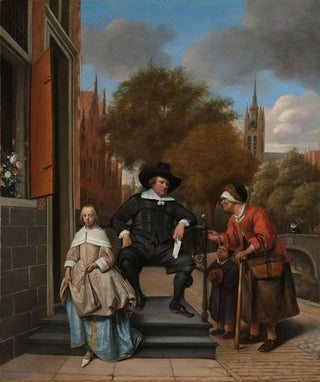Art print | Adolf and Catharina Croeser known as the mayor of Delft and his daughter - Jan Steen


View from behind

Frame (optional)
In the vibrant landscape of 17th-century Dutch painting, the "Art print" "Adolf and Catharina Croeser known as the mayor of Delft and his daughter" by Jan Steen stands out for its charm and depth. This intimate art print of a family, rooted in a rich social context, invites us to explore not only portraiture but also the subtleties of human relationships through the lens of everyday life. Steen, a master of visual storytelling, manages to capture the very essence of the characters while offering a glimpse into the customs of his time. Contemplating this art print, the viewer is transported to a scene where affection and family respect blend with an atmosphere of conviviality.
Style and uniqueness of the art print
The uniqueness of this art print lies in Jan Steen's characteristic style, which combines refined technique with a narrative approach. Vibrant colors and subtly modulated light create a warm ambiance, while the expressions of the characters reveal fascinating psychological depth. Adolf Croeser, as a mayor, is depicted with a dignity that reflects his status, while his daughter, Catharina, embodies freshness and innocence of youth. The meticulous details, such as clothing and accessories, testify to a particular attention paid to the social and cultural representation of the era. Steen does not merely paint static figures; he endows them with life and a story, thus inviting the viewer to question family dynamics and societal values of the Dutch society in the 17th century.
The artist and his influence
Jan Steen, born in 1626 in Leiden, is often regarded as one of the greatest masters of genre painting. His art print, rich in details and emotions, reflects a worldview where humor and satire coexist with a meticulous observation of reality. Steen succeeded in establishing himself thanks to his ability to capture moments of everyday life, transforming mundane scenes into vibrant canvases full of humanity. His influence extends well beyond his era, inspiring many artists.

Matte finish

View from behind

Frame (optional)
In the vibrant landscape of 17th-century Dutch painting, the "Art print" "Adolf and Catharina Croeser known as the mayor of Delft and his daughter" by Jan Steen stands out for its charm and depth. This intimate art print of a family, rooted in a rich social context, invites us to explore not only portraiture but also the subtleties of human relationships through the lens of everyday life. Steen, a master of visual storytelling, manages to capture the very essence of the characters while offering a glimpse into the customs of his time. Contemplating this art print, the viewer is transported to a scene where affection and family respect blend with an atmosphere of conviviality.
Style and uniqueness of the art print
The uniqueness of this art print lies in Jan Steen's characteristic style, which combines refined technique with a narrative approach. Vibrant colors and subtly modulated light create a warm ambiance, while the expressions of the characters reveal fascinating psychological depth. Adolf Croeser, as a mayor, is depicted with a dignity that reflects his status, while his daughter, Catharina, embodies freshness and innocence of youth. The meticulous details, such as clothing and accessories, testify to a particular attention paid to the social and cultural representation of the era. Steen does not merely paint static figures; he endows them with life and a story, thus inviting the viewer to question family dynamics and societal values of the Dutch society in the 17th century.
The artist and his influence
Jan Steen, born in 1626 in Leiden, is often regarded as one of the greatest masters of genre painting. His art print, rich in details and emotions, reflects a worldview where humor and satire coexist with a meticulous observation of reality. Steen succeeded in establishing himself thanks to his ability to capture moments of everyday life, transforming mundane scenes into vibrant canvases full of humanity. His influence extends well beyond his era, inspiring many artists.






